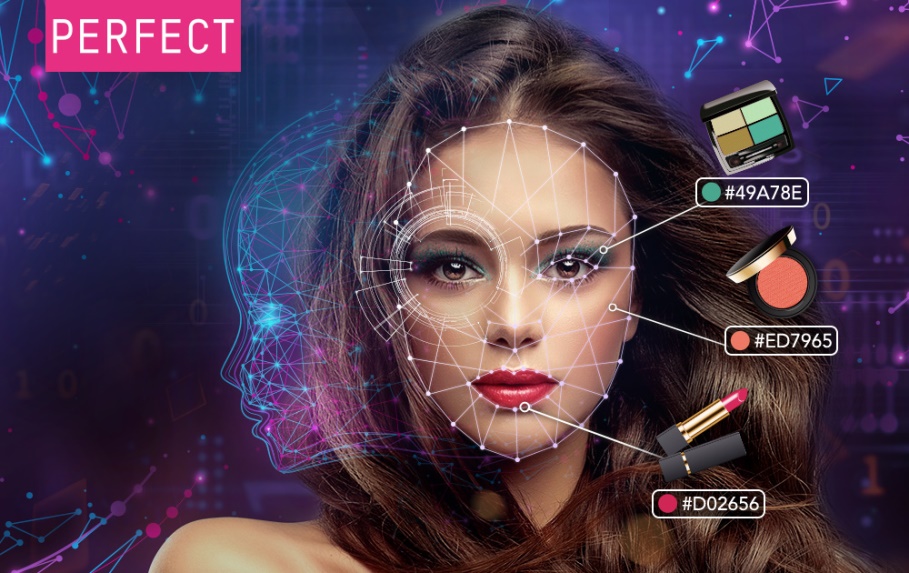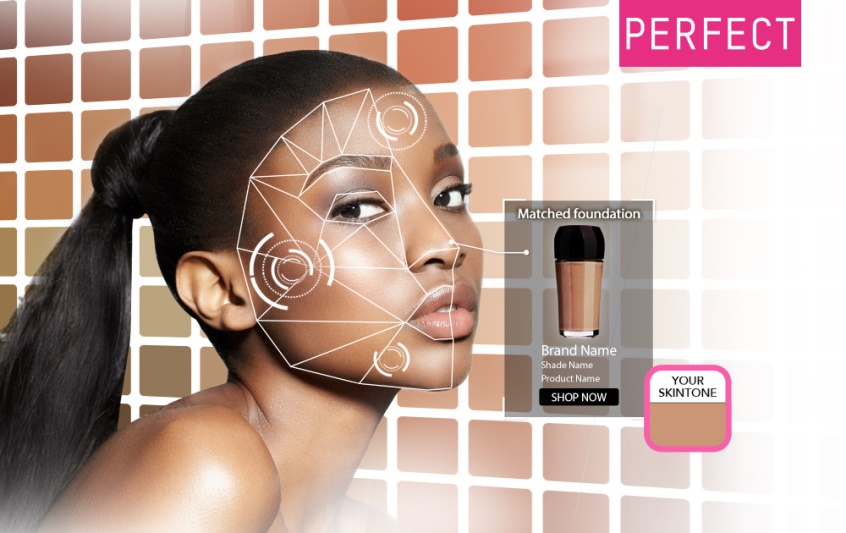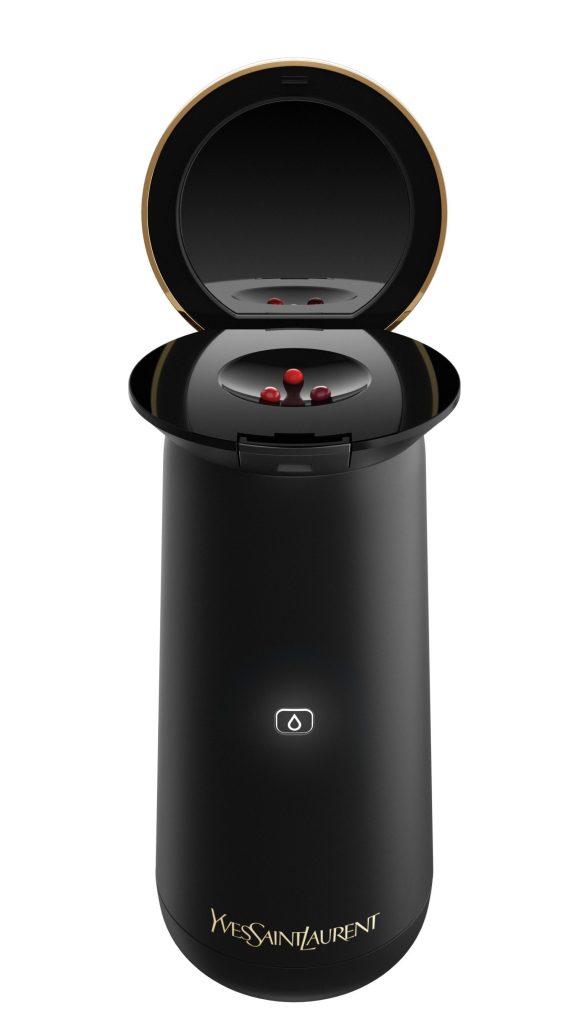
在邁入現(xiàn)代史之后的大部分時間里,人們購買美妝產(chǎn)品的方式一直都沒有什么變化,。
無論是為了要出席某項活動而購買一只新口紅,,還是要為冬季準備一支更保濕的唇膏,人們都會到訪其最喜愛的商店,,可能是某個繁華商業(yè)區(qū)的高檔美妝專柜,,也可能是就近的絲芙蘭,亦或是便利店,。
然而,,隨著21世紀00年代電商的崛起,,人們似乎只需要輕松動動手指就能夠買到美妝和護膚產(chǎn)品。
但人們很快發(fā)現(xiàn),,這種購物的靈活性是要以必要的購物體驗為代價的,。即便那些人們能夠想到的所有化妝品幾乎已盡數(shù)上線,但人們卻無法再通過試用各種色調(diào)的粉底來找到最合適的那種顏色,。同時,,諸如向銷售人員咨詢哪款洗面奶最合適敏感皮膚的對話,也已經(jīng)成為了一種遙遠的記憶,。
去年,這種美妝購物體驗的失落感甚至變得更加明顯,,因為新冠疫情迫使全球大多數(shù)人居家隔離,,與此同時,幾乎所有的實體店都因此而歇業(yè),。
突然間,,我們除了在線上購買美妝產(chǎn)品之外別無選擇。即便在一些店面重新營業(yè)之后,,受新的衛(wèi)生與安全預(yù)防措施的影響,,在購買前試用產(chǎn)品也被視為一種過時行為,而向銷售人員征求意見又可能會傳播或感染新冠病毒,。
因此,,有鑒于全球美妝行業(yè)營收預(yù)計將下滑20%至30%,而在線銷售又遠不能抵消實體店業(yè)績的下跌,,一些品牌開始啟用兩種長期以來一直在美妝行業(yè)邊緣徘徊的科技:人工智能和增強現(xiàn)實,。
多年來,數(shù)字創(chuàng)新一直在不動聲色地改變著美妝行業(yè),,然而,,體驗過相關(guān)服務(wù)的消費者將大部分創(chuàng)新視為噱頭、敗筆或過于小眾,。
這一領(lǐng)域的早期參與者使用粗糙的虛擬現(xiàn)實功能,,為用戶提供化妝品虛擬試用服務(wù)。其前景在理論上令人振奮,,但在實踐中卻是頻頻令人失望,,而且缺乏可操作性。

轉(zhuǎn)機出現(xiàn)在2014年,化妝品巨頭歐萊雅推出一款在智能手機上使用的虛擬化妝鏡Makeup Genius,,這是增強現(xiàn)實技術(shù)在美妝行業(yè)的首次試水,。
“這款應(yīng)用程序在第一年的下載量超過了2000萬,,讓我們的團隊聲名大振,同時也促使歐萊雅開始向人工智能數(shù)字服務(wù)邁進,?!睔W萊雅技術(shù)孵化器的全球副總裁基弗?巴洛克說:“技術(shù)孵化器部門認為,這類技術(shù)可能很快將在購物體驗中隨處可見,,而且我們的首席執(zhí)行官希望實現(xiàn)該技術(shù)的內(nèi)部化,,因此在當時,我們的首席數(shù)字官發(fā)起了對Modiface的收購,?!?/p>
作為當時這一領(lǐng)域的領(lǐng)先技術(shù),Modiface迅速成為了歐萊雅技術(shù)策略密不可分的一部分,,而且在公司的諸多數(shù)字創(chuàng)新領(lǐng)域內(nèi)發(fā)揮了重要作用,。
然而,它也引發(fā)了巴洛克對一個新問題的關(guān)注,。
“有時候產(chǎn)品種類不足,,我們得去創(chuàng)造,但有時候產(chǎn)品種類又太多,,我們得知道哪些產(chǎn)品適合自己,。”他解釋說,。
由于客戶在虛擬空間似乎擁有無限的產(chǎn)品可供試用,,結(jié)果令很多用戶感到不知所措,而且出現(xiàn)了購買倦怠情緒,。
巴洛克說:“我們有必要幫助消費者找到適合的產(chǎn)品,,因此我們開始使用人工智能技術(shù)?!?/p>
歐萊雅開發(fā)了一個可以測量膚色和皮膚狀況的實體店工具,,然后使用人工智能為客戶創(chuàng)建個性化配方。
這項技術(shù)最先用于蘭蔻的Le Teint Particulier粉底,,隨后延伸至修麗可的SkinScope,。
新冠疫情及其催生的數(shù)字美容解決方案新需求在某種程度上讓巴洛克及其團隊吃了一顆定心丸,市場對其創(chuàng)新的需求可謂是如日中天,。
他說:“這些技術(shù)讓人們對美妝領(lǐng)域更加好奇,,也提升了人們對這一行業(yè)的認知,有人很早便接受了這些技術(shù)并使用它,,與它建立聯(lián)系,。”
“此外,,我們還了解了人們在家中希望如何與產(chǎn)品進行互動的形式,,因此我們加速了策略的實施,,從而跟上整個世界的步伐?!?/p>
其中一個策略就是推出歐萊雅Perso智能系統(tǒng),,這個項目曾在數(shù)年前被擱淺,于去年重新被技術(shù)孵化中心啟動,。作為巴洛克所謂的“物質(zhì)數(shù)字化”項目中的最新內(nèi)容,,Perso是一款實體設(shè)備,結(jié)合了人工智能和增強現(xiàn)實技術(shù)對其進行賦能,。
上周,,歐萊雅推出首款使用該技術(shù)的消費產(chǎn)品——圣羅蘭 Rouge Sur Mesure。該產(chǎn)品使用圣羅蘭標志性的Velvet Cream Matte Finish口紅色彩配方,,僅需一鍵便能夠創(chuàng)造數(shù)千種定制色調(diào),。
在未來,歐萊雅計劃為其旗下眾多品牌打造類似基于Perso的設(shè)備,,覆蓋從奢華美妝線到藥房護膚線的所有產(chǎn)品。

作為幾家為數(shù)不多較早在這類技術(shù)研發(fā)上投入巨大精力和財力的公司,,在2020年年初新冠疫情爆發(fā)后,當消費行為在一夜間發(fā)生改變時,,歐萊雅處于明顯的優(yōu)勢地位,。
巴洛克說:“我認為歐萊雅策略了不起的地方在于,即便當時面臨著重重挑戰(zhàn),,公司依然對未來的愿景進行了投資,,如今,我們有了這支杰出的團隊,?!?/p>
“在某種意義上,我認為我們所擁有的主要優(yōu)勢在于公司過去10年開發(fā)的基礎(chǔ)設(shè)施,,正因如此我們?nèi)缃癫拍軌蛲瓿赡切┚哂幸欢◤?fù)雜度的事情,。”
其他一些品牌并不具有類似的數(shù)字創(chuàng)新歷史,,也沒有必要的內(nèi)部資源來滿足市場對人工智能和增強現(xiàn)實技術(shù)服務(wù)不斷增長的需求,。
為了尋找解決方案,這些公司將目光瞄向了公司外部,。隨著近些年來消費者對此類技術(shù)的興趣不斷增長,,品牌巨頭、零售商和獨立品牌都開始轉(zhuǎn)向玩美移動公司,。這是一家位于中國臺灣的美容科技提供商,,亦是人工智能和增強現(xiàn)實解決方案領(lǐng)域的先驅(qū),。
自2015年成立以來,公司已經(jīng)利用增強現(xiàn)實技術(shù),、面部識別和顏色匹配打造了多項服務(wù),。而且事實證明,這些服務(wù)在美妝行業(yè)的數(shù)字化進程中發(fā)揮了不可估量的作用,。
玩美移動公司的高級副總裁兼總經(jīng)理Wayne Liu表示:“最初,,公司的銷售是有些困難的,因為當時的美妝行業(yè)非常傳統(tǒng),,而且人們認為這種數(shù)字服務(wù)產(chǎn)品會有色差,。然而,在向雅詩蘭黛這類品牌進行概念驗證展示之后,,公司的產(chǎn)品引發(fā)了巨大的反響,,雅詩蘭黛成為了我們合作的第一家公司?!?/p>
2019年,,雅詩蘭黛采用了玩美移動公司的YouCam Makeup虛擬試用顏色匹配體驗來打造iMatch Virtual Shade Expert,后者可以幫助客戶找到雅詩蘭黛持妝DW粉底液(Double Wear Stay-in-Place Makeup)以及沁水輕粉底液(Futurist Hydra Rescue Moisturizing Makeup)產(chǎn)品中最適合他們的色號,,并能夠看到相應(yīng)的虛擬妝容,。
在Shade Expert獲得成功,并且人們意識到疫情期間相關(guān)數(shù)字美妝服務(wù)的巨大需求之后,,雅詩蘭黛于去年年底再一次與玩美移動合作,,打造了iMatch Virtual Skin Analysis這款自助式數(shù)字護膚診斷工具,它采用了最新的YouCam人工智能技術(shù),,來揭示皮膚所需的個性化護理方案,。
雅詩蘭黛全球消費營銷高級副總裁瓊?羅曼說:“我們的目標是為客戶提供最個性化、最生動的體驗,,這也是公司品牌的核心價值觀,。對人工智能技術(shù)的運用能夠讓我們提供精準的個性化產(chǎn)品推薦,同時讓消費者獲得同樣的深入接觸體驗,,而且不受購物場景空間的限制,。”
個人護理和醫(yī)療巨頭強生旗下的公司露得清在2020年年初也向玩美移動尋求幫助,,來打造其最新版皮膚分析工具Skin360,,這款應(yīng)用程序此前曾經(jīng)需要花60美元購買手機附件才可以使用。
玩美移動的YouCam技術(shù)讓該應(yīng)用程序直接使用智能手機鏡頭便可以提供180度的自拍分析,,而由玩美移動公司和強生研發(fā)團隊合作開發(fā)的算法則能夠分析超過2000多種面部膚質(zhì)的10萬個皮膚像素點,,并提供超過250萬條可能的產(chǎn)品推薦。
自重新推出之后,,Skin360應(yīng)用程序斬獲了11.5萬次的下載量,,露得清認為這一應(yīng)用程序的大熱得益于人們對居家專業(yè)級皮膚評估需求的攀升,。
該品牌去年還與谷歌和YouTube合作,使用其新開發(fā)的Virtual Try On技術(shù),,讓消費者在觀看YouTube視頻時,,與他們最喜愛的美妝博主們一道試用露得清的唇彩。
公司目前正在與亞馬遜的美妝試用技術(shù)合作,。
然而,,在密切關(guān)注疫情期間消費行為向線上轉(zhuǎn)變的現(xiàn)象之后,露得清推出了自己的虛擬試用解決方案,,它借助了玩美移動的YouCam Makeup技術(shù),,將于2021年第一季度面世。
露得清的痤瘡創(chuàng)新與皮膚科技總監(jiān)羅根?麥克吉爾稱:“最終,,隨著線上購物的增長以及零售商出于衛(wèi)生考慮而取消實體店面測試器,,數(shù)字功能的進步將幫助人們把握市場機遇?!?/p>
“通過像露得清Skin360這類能夠?qū)崿F(xiàn)虛擬試用美妝產(chǎn)品的應(yīng)用程序平臺和技術(shù),,我們的目標是讓消費者直接掌控自己的護膚權(quán),讓他們可以更多地了解自身的皮膚狀況,,并能更加便利地找到適合他們獨特需求的產(chǎn)品,。”
盡管基于人工智能和增強現(xiàn)實的美妝創(chuàng)新早在疫情之前便已面世,,但疫情及其給化妝品行業(yè)帶來的問題,,毫無疑問加速了消費者對此類解決方案的采納,。
正因為如此,,我們幾乎可以肯定的是,對美妝科技的需求將在未來持續(xù)很長一段時間,,即便傳統(tǒng)的實體店購買體驗回歸常態(tài)之后亦是如此,。
然而,化妝品行業(yè)的眾多巨頭并不相信實體店面在未來絲毫沒有立足之地,,而技術(shù)創(chuàng)新在實體店依然有所作為,。
玩美移動的Wayne Liu解釋說:“一方面,作為技術(shù)提供商,,我們將提供客戶所需的技術(shù),,以便消費者在家中也能得到實體店的購物體驗。然而在另一方面,,一些與我們合作的美容品牌的確還在依賴實體店,,而且它們也確實需要讓消費者回歸實體店,并通過新的方法來實現(xiàn)這一點,。因此,,相關(guān)的店面技術(shù)便有了用武之地,。”
他還指出,,公司的重點已經(jīng)不再是解決眼下的問題,,而是開始著眼于未來的長遠問題。(財富中文網(wǎng))
譯者:馮豐
審校:夏林
在邁入現(xiàn)代史之后的大部分時間里,,人們購買美妝產(chǎn)品的方式一直都沒有什么變化,。
無論是為了要出席某項活動而購買一只新口紅,還是要為冬季準備一支更保濕的唇膏,,人們都會到訪其最喜愛的商店,,可能是某個繁華商業(yè)區(qū)的高檔美妝專柜,也可能是就近的絲芙蘭,,亦或是便利店,。
然而,隨著21世紀00年代電商的崛起,,人們似乎只需要輕松動動手指就能夠買到美妝和護膚產(chǎn)品,。
但人們很快發(fā)現(xiàn),這種購物的靈活性是要以必要的購物體驗為代價的,。即便那些人們能夠想到的所有化妝品幾乎已盡數(shù)上線,,但人們卻無法再通過試用各種色調(diào)的粉底來找到最合適的那種顏色。同時,,諸如向銷售人員咨詢哪款洗面奶最合適敏感皮膚的對話,,也已經(jīng)成為了一種遙遠的記憶。
去年,,這種美妝購物體驗的失落感甚至變得更加明顯,,因為新冠疫情迫使全球大多數(shù)人居家隔離,與此同時,,幾乎所有的實體店都因此而歇業(yè),。
突然間,我們除了在線上購買美妝產(chǎn)品之外別無選擇,。即便在一些店面重新營業(yè)之后,,受新的衛(wèi)生與安全預(yù)防措施的影響,在購買前試用產(chǎn)品也被視為一種過時行為,,而向銷售人員征求意見又可能會傳播或感染新冠病毒,。
因此,有鑒于全球美妝行業(yè)營收預(yù)計將下滑20%至30%,,而在線銷售又遠不能抵消實體店業(yè)績的下跌,,一些品牌開始啟用兩種長期以來一直在美妝行業(yè)邊緣徘徊的科技:人工智能和增強現(xiàn)實。
多年來,數(shù)字創(chuàng)新一直在不動聲色地改變著美妝行業(yè),,然而,,體驗過相關(guān)服務(wù)的消費者將大部分創(chuàng)新視為噱頭、敗筆或過于小眾,。
這一領(lǐng)域的早期參與者使用粗糙的虛擬現(xiàn)實功能,,為用戶提供化妝品虛擬試用服務(wù)。其前景在理論上令人振奮,,但在實踐中卻是頻頻令人失望,,而且缺乏可操作性。
轉(zhuǎn)機出現(xiàn)在2014年,,化妝品巨頭歐萊雅推出一款在智能手機上使用的虛擬化妝鏡Makeup Genius,,這是增強現(xiàn)實技術(shù)在美妝行業(yè)的首次試水。
“這款應(yīng)用程序在第一年的下載量超過了2000萬,,讓我們的團隊聲名大振,,同時也促使歐萊雅開始向人工智能數(shù)字服務(wù)邁進?!睔W萊雅技術(shù)孵化器的全球副總裁基弗?巴洛克說:“技術(shù)孵化器部門認為,,這類技術(shù)可能很快將在購物體驗中隨處可見,而且我們的首席執(zhí)行官希望實現(xiàn)該技術(shù)的內(nèi)部化,,因此在當時,,我們的首席數(shù)字官發(fā)起了對Modiface的收購?!?/p>
作為當時這一領(lǐng)域的領(lǐng)先技術(shù),,Modiface迅速成為了歐萊雅技術(shù)策略密不可分的一部分,而且在公司的諸多數(shù)字創(chuàng)新領(lǐng)域內(nèi)發(fā)揮了重要作用,。
然而,,它也引發(fā)了巴洛克對一個新問題的關(guān)注。
“有時候產(chǎn)品種類不足,,我們得去創(chuàng)造,,但有時候產(chǎn)品種類又太多,,我們得知道哪些產(chǎn)品適合自己,。”他解釋說,。
由于客戶在虛擬空間似乎擁有無限的產(chǎn)品可供試用,,結(jié)果令很多用戶感到不知所措,而且出現(xiàn)了購買倦怠情緒,。
巴洛克說:“我們有必要幫助消費者找到適合的產(chǎn)品,,因此我們開始使用人工智能技術(shù)?!?/p>
歐萊雅開發(fā)了一個可以測量膚色和皮膚狀況的實體店工具,,然后使用人工智能為客戶創(chuàng)建個性化配方,。
這項技術(shù)最先用于蘭蔻的Le Teint Particulier粉底,隨后延伸至修麗可的SkinScope,。
新冠疫情及其催生的數(shù)字美容解決方案新需求在某種程度上讓巴洛克及其團隊吃了一顆定心丸,,市場對其創(chuàng)新的需求可謂是如日中天。
他說:“這些技術(shù)讓人們對美妝領(lǐng)域更加好奇,,也提升了人們對這一行業(yè)的認知,,有人很早便接受了這些技術(shù)并使用它,與它建立聯(lián)系,?!?/p>
“此外,我們還了解了人們在家中希望如何與產(chǎn)品進行互動的形式,,因此我們加速了策略的實施,,從而跟上整個世界的步伐?!?/p>
其中一個策略就是推出歐萊雅Perso智能系統(tǒng),,這個項目曾在數(shù)年前被擱淺,于去年重新被技術(shù)孵化中心啟動,。作為巴洛克所謂的“物質(zhì)數(shù)字化”項目中的最新內(nèi)容,,Perso是一款實體設(shè)備,結(jié)合了人工智能和增強現(xiàn)實技術(shù)對其進行賦能,。
上周,,歐萊雅推出首款使用該技術(shù)的消費產(chǎn)品——圣羅蘭 Rouge Sur Mesure。該產(chǎn)品使用圣羅蘭標志性的Velvet Cream Matte Finish口紅色彩配方,,僅需一鍵便能夠創(chuàng)造數(shù)千種定制色調(diào),。
在未來,歐萊雅計劃為其旗下眾多品牌打造類似基于Perso的設(shè)備,,覆蓋從奢華美妝線到藥房護膚線的所有產(chǎn)品,。
作為幾家為數(shù)不多較早在這類技術(shù)研發(fā)上投入巨大精力和財力的公司,在2020年年初新冠疫情爆發(fā)后,,當消費行為在一夜間發(fā)生改變時,,歐萊雅處于明顯的優(yōu)勢地位。
巴洛克說:“我認為歐萊雅策略了不起的地方在于,,即便當時面臨著重重挑戰(zhàn),,公司依然對未來的愿景進行了投資,如今,,我們有了這支杰出的團隊,。”
“在某種意義上,我認為我們所擁有的主要優(yōu)勢在于公司過去10年開發(fā)的基礎(chǔ)設(shè)施,,正因如此我們?nèi)缃癫拍軌蛲瓿赡切┚哂幸欢◤?fù)雜度的事情,。”
其他一些品牌并不具有類似的數(shù)字創(chuàng)新歷史,,也沒有必要的內(nèi)部資源來滿足市場對人工智能和增強現(xiàn)實技術(shù)服務(wù)不斷增長的需求,。
為了尋找解決方案,這些公司將目光瞄向了公司外部,。隨著近些年來消費者對此類技術(shù)的興趣不斷增長,,品牌巨頭、零售商和獨立品牌都開始轉(zhuǎn)向玩美移動公司,。這是一家位于中國臺灣的美容科技提供商,,亦是人工智能和增強現(xiàn)實解決方案領(lǐng)域的先驅(qū)。
自2015年成立以來,,公司已經(jīng)利用增強現(xiàn)實技術(shù),、面部識別和顏色匹配打造了多項服務(wù)。而且事實證明,,這些服務(wù)在美妝行業(yè)的數(shù)字化進程中發(fā)揮了不可估量的作用,。
玩美移動公司的高級副總裁兼總經(jīng)理Wayne Liu表示:“最初,公司的銷售是有些困難的,,因為當時的美妝行業(yè)非常傳統(tǒng),,而且人們認為這種數(shù)字服務(wù)產(chǎn)品會有色差。然而,,在向雅詩蘭黛這類品牌進行概念驗證展示之后,,公司的產(chǎn)品引發(fā)了巨大的反響,雅詩蘭黛成為了我們合作的第一家公司,?!?/p>
2019年,雅詩蘭黛采用了玩美移動公司的YouCam Makeup虛擬試用顏色匹配體驗來打造iMatch Virtual Shade Expert,,后者可以幫助客戶找到雅詩蘭黛持妝DW粉底液(Double Wear Stay-in-Place Makeup)以及沁水輕粉底液(Futurist Hydra Rescue Moisturizing Makeup)產(chǎn)品中最適合他們的色號,,并能夠看到相應(yīng)的虛擬妝容。
在Shade Expert獲得成功,,并且人們意識到疫情期間相關(guān)數(shù)字美妝服務(wù)的巨大需求之后,,雅詩蘭黛于去年年底再一次與玩美移動合作,打造了iMatch Virtual Skin Analysis這款自助式數(shù)字護膚診斷工具,,它采用了最新的YouCam人工智能技術(shù),,來揭示皮膚所需的個性化護理方案,。
雅詩蘭黛全球消費營銷高級副總裁瓊?羅曼說:“我們的目標是為客戶提供最個性化,、最生動的體驗,這也是公司品牌的核心價值觀。對人工智能技術(shù)的運用能夠讓我們提供精準的個性化產(chǎn)品推薦,,同時讓消費者獲得同樣的深入接觸體驗,,而且不受購物場景空間的限制?!?/p>
個人護理和醫(yī)療巨頭強生旗下的公司露得清在2020年年初也向玩美移動尋求幫助,,來打造其最新版皮膚分析工具Skin360,這款應(yīng)用程序此前曾經(jīng)需要花60美元購買手機附件才可以使用,。
玩美移動的YouCam技術(shù)讓該應(yīng)用程序直接使用智能手機鏡頭便可以提供180度的自拍分析,,而由玩美移動公司和強生研發(fā)團隊合作開發(fā)的算法則能夠分析超過2000多種面部膚質(zhì)的10萬個皮膚像素點,并提供超過250萬條可能的產(chǎn)品推薦,。
自重新推出之后,,Skin360應(yīng)用程序斬獲了11.5萬次的下載量,露得清認為這一應(yīng)用程序的大熱得益于人們對居家專業(yè)級皮膚評估需求的攀升,。
該品牌去年還與谷歌和YouTube合作,,使用其新開發(fā)的Virtual Try On技術(shù),讓消費者在觀看YouTube視頻時,,與他們最喜愛的美妝博主們一道試用露得清的唇彩,。
公司目前正在與亞馬遜的美妝試用技術(shù)合作。
然而,,在密切關(guān)注疫情期間消費行為向線上轉(zhuǎn)變的現(xiàn)象之后,,露得清推出了自己的虛擬試用解決方案,它借助了玩美移動的YouCam Makeup技術(shù),,將于2021年第一季度面世,。
露得清的痤瘡創(chuàng)新與皮膚科技總監(jiān)羅根?麥克吉爾稱:“最終,隨著線上購物的增長以及零售商出于衛(wèi)生考慮而取消實體店面測試器,,數(shù)字功能的進步將幫助人們把握市場機遇,。”
“通過像露得清Skin360這類能夠?qū)崿F(xiàn)虛擬試用美妝產(chǎn)品的應(yīng)用程序平臺和技術(shù),,我們的目標是讓消費者直接掌控自己的護膚權(quán),,讓他們可以更多地了解自身的皮膚狀況,并能更加便利地找到適合他們獨特需求的產(chǎn)品,?!?/p>
盡管基于人工智能和增強現(xiàn)實的美妝創(chuàng)新早在疫情之前便已面世,但疫情及其給化妝品行業(yè)帶來的問題,,毫無疑問加速了消費者對此類解決方案的采納,。
正因為如此,我們幾乎可以肯定的是,,對美妝科技的需求將在未來持續(xù)很長一段時間,,即便傳統(tǒng)的實體店購買體驗回歸常態(tài)之后亦是如此,。
然而,化妝品行業(yè)的眾多巨頭并不相信實體店面在未來絲毫沒有立足之地,,而技術(shù)創(chuàng)新在實體店依然有所作為,。
玩美移動的Wayne Liu解釋說:“一方面,作為技術(shù)提供商,,我們將提供客戶所需的技術(shù),,以便消費者在家中也能得到實體店的購物體驗。然而在另一方面,,一些與我們合作的美容品牌的確還在依賴實體店,,而且它們也確實需要讓消費者回歸實體店,并通過新的方法來實現(xiàn)這一點,。因此,,相關(guān)的店面技術(shù)便有了用武之地?!?/p>
他還指出,,公司的重點已經(jīng)不再是解決眼下的問題,而是開始著眼于未來的長遠問題,。(財富中文網(wǎng))
譯者:馮豐
審校:夏林
For most of modern history, it was the same routine. Whenever we needed a new lipstick for a big event or a more hydrating moisturizer in preparation for winter, a visit to our favorite store was in order—be it the finest beauty counters at Saks Fifth Avenue, the nearest Sephora, or the local CVS. With the rise of e-commerce in the 2000s, it seemed we could finally buy makeup and skin care with the ease of a few clicks.
But it soon became clear that this newfound flexibility came at the cost of a necessary buying experience. Even with every imaginable cosmetics product available online, we could no longer try on eight shades of foundation to find that one perfect match, and consulting the wisdom of a salesperson on which cleanser is best for sensitive skin was but a distant memory.
This disparity became even more glaring last year, when the COVID-19 pandemic forced much of the world to stay at home and temporarily closed the doors of nearly all brick-and-mortar stores. Suddenly, we had no option but to procure our beauty online, and even after some stores reopened, trying products before buying was rendered obsolete thanks to new health and safety precautions, and asking the advice of a salesperson presented the risk of spreading or contracting the deadly virus. So, with global beauty-industry revenues expected to fall 20% to 30% and online sales far from offsetting the decline in in-store sales, some brands turned to two technologies that had long been on the fringes of the beauty world: artificial intelligence (A.I.) and augmented reality (A.R.).
For many years, digital innovation has been quietly disrupting the beauty industry, but the touch points consumers saw most were often gimmicky, faulty, or simply far too niche. Early players in the space utilized primitive VR abilities to enable users to virtually try on makeup—an exciting prospect in theory but frequently disappointing and unrealistic in practice.
In 2014, however, cosmetics giant L’Oréal launched Makeup Genius, a virtual makeup mirror that worked on smartphones, and it become the first adoption of augmented reality in beauty to really go mainstream.
“It had over 20 million downloads in the first year and led to our team becoming quite visible, but it also started our movement toward A.I.-based digital services,” says Guive Balooch, global vice president of L’Oréal’s Technology Incubator. “The organization thought this kind of technology would soon be everywhere in the shopping experience, and our CEO wanted to internalize that, so that’s when our chief digital officer led the acquisition of Modiface.”
At that stage a leading technology in this arena, Modiface quickly became an integral part of L’Oréal’s tech strategy and has played a key role in many of the company’s digital innovations since, but it also brought a new problem to Balooch’s attention.
“Sometimes there aren’t enough products, and we need to create them, but other times, there are too many products, and we need to know which ones are right for us,” he explains. With seemingly limitless options available to customers to virtually try on, many users felt overwhelmed and experienced purchasing paralysis as a result. “We needed to help them find what was right for them, so we started using A.I.,” Balooch says.
Starting with Lanc?me’s Le Teint Particulier foundation and continuing with SkinCeuticals’ SkinScope, L’Oréal developed an in-store tool that could measure skin tone and skin conditions and then use A.I. to create a personalized formula for the customer.
The pandemic and the new demand it’s brought for digital beauty solutions have served as somewhat of a validation for Balooch and his team, whose innovations are seeing more need than ever.
“It’s made people more curious and knowledgeable about the space, and there’s been earlier adoption and connection,” he says. “We’ve also seen how people are wanting to interact with products at home, so we’ve accelerated aspects of our strategy to keep up with how the world is moving.”
One such aspect is the launch of L’Oréal’s Perso, a project the technology incubator restarted last year after putting it on hold years earlier. The latest in what Balooch calls “phygital” projects, Perso is a physical device that uses A.I. and A.R. technologies to power it.
This week, L’Oréal will launch the first consumer product using the technology, Yves Saint Laurent Rouge Sur Mesure Powered by Perso, which will utilize color cartridge sets of YSL’s iconic Velvet Cream Matte Finish lipsticks to create thousands of bespoke shades with a single touch. In the future, L’Oréal plans to create similar Perso-powered devices with many of its brands, from luxury makeup to drugstore skin care, to enable customers to fulfill all of their changing cosmetics needs easily and at home.
As one of only a few beauty brands to devote substantial attention and investment to developing technology so early on, L’Oréal was at an obvious advantage when the pandemic hit in early 2020 and consumer behavior shifted nearly overnight.
“I’m obviously a bit biased, but what I think is amazing about what L’Oreal did was that they invested in the vision of the future even when there were challenges, and we now have this amazing team,” Balooch says. “In a way, I think the major advantage that we have is the infrastructure that we’ve developed over the last 10 years, and that’s why we’re able to do things that are a little bit more complicated.”
Other brands that lacked the same history of digital innovation or the internal resources necessary to meet rising demand for A.I.- and A.R.-powered services looked to solutions beyond their company gates. As consumer interest in such technology has grown in recent years, colossal brands, retailers, and indie brands alike have turned to Perfect Corp, a Taiwan-based beauty tech provider that has pioneered A.I. and A.R. solutions. In business since 2015, the company has built several services harnessing A.R. technology, facial recognition, and color matching, and it’s proved invaluable to beauty’s push toward digital.
“At the very beginning, it was a little bit hard to sell because the beauty industry is very traditional, and there was the thinking that digital would skew colors,” says Wayne Liu, senior vice president and general manager of Perfect Corp. “But after showing proof of concept with a brand like Estée Lauder, which was really the first company we worked with, we saw a huge response.”
In 2019, Estée Lauder called upon Perfect Corp’s YouCam Makeup virtual try-on-color match experience to create the iMatch Virtual Shade Expert, which offers customers a way to find their preferred shade of Double Wear Stay-in-Place Makeup and Futurist Hydra Rescue Moisturizing Makeup and see it virtually applied in real time. Following the Shade Expert’s success and aware of the mounting need for at-home solutions in the wake of the pandemic, Estée once again partnered with Perfect Corp late last year to build iMatch Virtual Skin Analysis, a self-guided digital skin care diagnostic tool that leverages the latest YouCam A.I. technology to reveal what skin needs with a personalized skin care regimen.
“Our goal is to provide our customer with the most personalized and engaging experiences, something that is at the core of our brand DNA,” says Jon Roman, Estée Lauder’s senior vice president of global consumer marketing. “And leveraging A.I. technologies allows us to provide personalized and accurate product recommendations, while enabling her to have the same high-touch experience whether she’s shopping in-store or online.”
Similarly, Neutrogena, owned by personal care and medical behemoth Johnson & Johnson, sought the help of Perfect Corp in early 2020 to create an updated version of its Skin360 app, a skin analysis tool which previously required a separate $60 phone attachment to use. Perfect Corp’s YouCam technology allowed the app to instead provide a 180-degree selfie analysis simply using a smartphone camera, and the algorithm, developed in partnership between the Taiwan firm and Johnson & Johnson’s Research & Development team, analyzes more than 100,000 skin pixels over 2,000 facial attributes and offers more than 2.5 million possible product recommendations. Since its relaunch, the Skin360 app has seen more than 115,000 downloads, a rise in popularity that Neutrogena believes can be attributed to the increasing demand for at-home, dermatologist-grade skin assessment.
The brand also collaborated with Google and YouTube late last year to utilize its new Virtual Try On technology, allowing consumers to try on Neutrogena’s lip shades alongside their favorite beauty influencers while watching their YouTube videos, and it is currently working with Amazon’s makeup try-on technology. But after paying close attention to the consumer shift to online shopping during the pandemic, Neutrogena has created its own virtual try-on solution, with the help of Perfect Corp’s YouCam Makeup technology, and it is set to launch within the first quarter of 2021.
“Ultimately, the evolution of digital capabilities addresses market opportunities as e-commerce shopping grows and as retailers remove physical in-store testers to avoid hygiene concerns,” says Logan McGill, the brand’s director of acne innovation and skin tech. “Through platforms like our Neutrogena Skin360 app and technologies that enable virtual try-on of Neutrogena Makeup products, our aim is to put the power of skin health directly in the hands of our consumers, enabling them to learn more about their skin and to more easily find the products that are right for their unique needs.”
While A.I.- and A.R.-powered beauty innovations were in the works long before COVID-19 was even a part of our collective vocabulary, the pandemic and the problems it’s presented to the beauty industry have undoubtedly sped up the consumer adoption of such solutions. As such, it seems all but certain that demand for beauty tech will continue well into the future, even as traditional in-store buying experiences once again become feasible.
But many of beauty’s biggest players aren’t yet convinced that there won’t be a place for brick-and-mortar stores in the future, and the tech innovators are hedging their bets accordingly.
“On the one hand, as a technology provider, we provide the technology that customers need to recreate an in-store experience at home,” explains Perfect Corp’s Liu. “But on the other hand, some of the beauty brands that we work with really do rely on the store, and they do still need to get the consumer back to the store and think about new ways to do that, which is where in-store technology can come into play.” Rather than create solutions simply for today’s problems, he says, it’s about solving the problems that will be important for many years to come.






